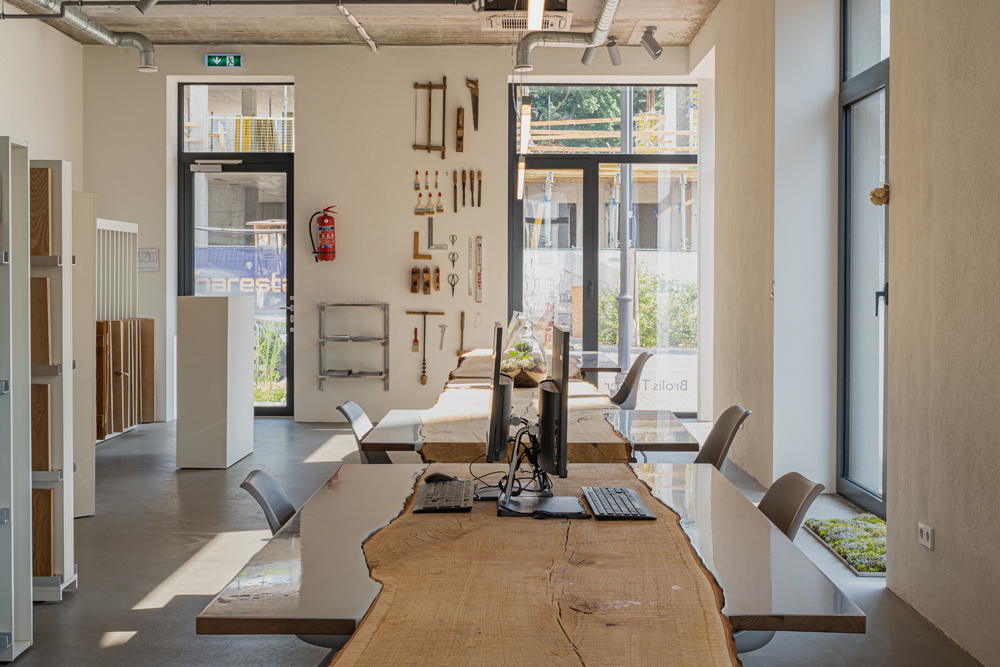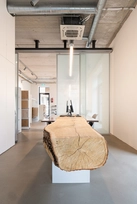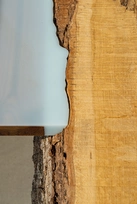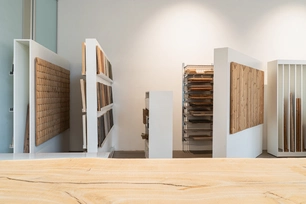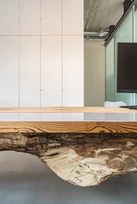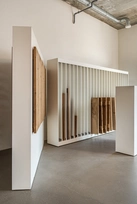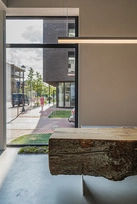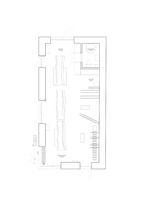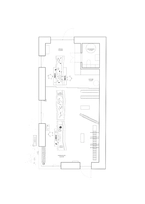Apie projektą:
Šalis: Lietuva
Plotas: 67,18 m²
Brolis Timber parduotuvė
Brolis Timber parduotuvė įsikūrusi Paupyje. Šis rajonas – pirmasis Vilniaus miesto pramonės židinys, iki Antrojo Pasaulinio karo vadintas Paplauja. Vietovę žymėjo vandenys – Vilnia iš šiaurės ir šaltiniai iš pietų. XVIII–XIX a. sandūroje, išardžius Vilniaus gynybinę sieną, Paplauja atgijo naujam gyvenimui. Čia kūrėsi įvairių tautybių pirkliai, pramoninkai ir amatininkai, veikė lentpjūvė. Aukštaičių gatvės vietoje, šalia dabartinės parduotuvės, tekėjo Perkasos kanalas, kuriuo medienos prekeiviai gabeno rąstus.
Mediena – Brolis Timber verslo turinys ir gaminių šaltinis. Atvertas medienos rąstas parduotuvėje virsta jos šerdimi ir širdimi, pagrindiniu interjero elementu, įkūnijančiu naujosios erdvės koncepcijos sluoksnius.
Pirmasis sluoksnis – istorinis. Įspūdingų raštų kamienas simbolizuoja istorinį kanalą, kurio dėka čia kūrėsi pramonė ir amatai. Priauginti, epoksidine derva lieti darbastaliai ir jų atspindžiai judančiose pertvarose įprasmina čia tekėjusį vandenį.
Antrasis sluoksnis – funkcinis. Rąstas naudojamas kaip darbo ir susitikimų stalas, vieta pavyzdžių gamybai ar peržiūrai. Tai aliuzija į Paupyje buvusią lentpjūvę. Stumdomos pertvaros leidžia keisti erdvę pagal poreikį, sujungiant arba atskiriant parduotuvės ir ofiso dalis.
Trečiasis sluoksnis primena, kad čia būta labai gamtiškos vietovės. Samanų ir kerpių intarpai sušvelnina perėjimą iš vidaus į išorę, kurią priimame kaip platesnį interjero kontekstą, apimantį gamtą ir kultūrą.
English
Brolis Timber is located in Paupys, historically, the first industrial development area in Vilnius. Until WWII the district was called Paplauja (the name refers to the rise and descent of water) as it was bordered by the river Vilnia to the north and the springs to the south. In the early 1900s, after dismantling the Vilnius City wall, multicultural merchants, manufacturers and craftsmen, including sawmill operators and carpenters, rediscovered and settled in Paplauja, making it a bustling business area. The current Aukštaičių Street, where the new store can be found, was formerly an artificial channel connecting Vilnius waterways and serving for logistics of logs and other goods.
Wood is the content and source of Brolis Timber production. Therefore, oak log becomes the key interior element - the core and heart - revealing the conceptual layers of design.
Impressive flow of wood grain embodies the historical layer – the Perkasa channel, which fueled the development of industry and crafts. Epoxy covered surfaces of the extended workplaces and their reflections on the glass partitions symbolize the formerly presence of water.
The second layer is functional – the log serves as a desk and a meeting table, as well as a desktop to develop or showcase production samples. This also hints of the timber manufacturing that once happened in this area. Sliding glass partitions allow to transform the space according to the need – connecting or dividing the areas of the shop and the office.
Thirdly, the layer of nature – organic inclusions of moss and lichens remind of the former landscape and soften the transition from inside to outside, as there is just another larger interior outside the shop’s windows, encompassing all nature and culture around.
Nuotraukos: Andrej Vasilenko
© 2025 visos teisės saugomos
Norėdami išsaugoti, prisijunkite.
Siekdami užtikrinti geriausią Jūsų naršymo patirtį, šiame portale naudojame slapukus.
Daugiau informacijos ir pasirinkimo galimybių rasite paspaudus mygtuką „Nustatymai“.
Jei ateityje norėsite pakeisti šį leidimą, tą galėsite bet kada galėsite padaryti paspaudžiant portalo apačioje esančią „Slapukų nustatymai“ nuorodą.
Tai portalo veikimui būtini slapukai, kurie yra įjungti visada. Šių slapukų naudojimą galima išjungti tik pakeitus naršyklės nuostatas.
| Pavadinimas | Aprašymas | Galiojimo laikas |
|---|---|---|
| storage_consent | Šiame slapuke išsaugoma informacija, kurias šiuose nustatymuose matomų slapukų grupes leidžiate naudoti. | 365 dienos |
| PHPSESSID | Sesijos identifikacinis numeris, reikalingas bazinių portalo funkcijų (pavyzdžiui, galimybei prisijungti, užildyti užklausos formą ir kitų) veikimo užtrikinimui. | Iki naršyklės uždarymo |
| REMEMBERME | Prisijungimui prie asmeninės paskyros portale naudojamas slapukas. | 1 mėnuo |
| OAID | Portalo vidinės reklaminių skydelių valdymo sistemos slapukas. | 1 metai |
| __eoi | Saugumo paskirtį atliekantis Google paslaugose (Google AdSense, AdSense for Search, Display & Video 360, Google Ad Manager, Google Ads) naudojamas slapukas. | 6 mėnesiai |
| sender_popup_shown_* | Naujienlaiškio užsakymo formos nustatymai. | 1 mėnuo |
Slapukai skirti informacijos apie portalo lankomumą rinkimui.
| Pavadinimas | Aprašymas | Galiojimo laikas |
|---|---|---|
| _ga | Google Analytics statistikos slapukas | 2 metai |
| _ga_* | Google Analytics statistikos slapukas | 2 metai |
Rinkodaros arba reklamos slapukai, kurie naudojami siekiant parodyti pasiūlymus ar kitą informaciją, kuri galėtų Jus sudominti.
| Pavadinimas | Aprašymas | Galiojimo laikas |
|---|---|---|
| test_cookie | Naudojamas Google paslaugose (Google AdSense, AdSense for Search, Display & Video 360, Google Ad Manager, Google Ads). | 15 minučių |
| __Secure-3PAPISID | Naudojama Google paslaugose vartotojo nustatymų ir informacijos saugojimui. | 13 mėnesių |
| __Secure-3PSID | Naudojama Google paslaugose vartotojo nustatymų ir informacijos saugojimui. | 13 mėnesių |
| _fbp | Facebook platformos slapukas. | 90 dienų |
| _fbc | Facebook platformos slapukas. | 90 dienų |
| datr | Facebook platformos slapukas. | 1 metai |

